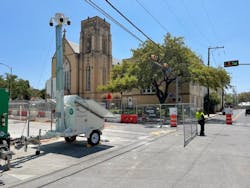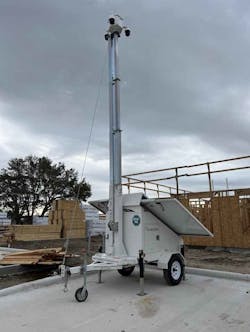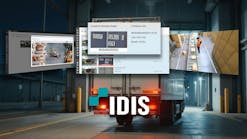AI-backed mobile security video surveillance solutions allow for a proactive approach
Last year, there was a 71% increase in physical attacks on critical U.S. infrastructure, according to a U.S. government report. Whether it's manufacturing, processing, or energy production, operational continuity is paramount. Yet, the alarming increase in the number of physical attacks that target these facilities – which could include theft or damage to expensive equipment – is putting uptime in jeopardy.
When it comes to protecting these facilities from an attack, a range of options from CCTV systems to 24-hour security guards are often deployed. However, CCTV security installations have typically focused on “inside the perimeter” protection and often lack the teeth needed to be a deterrent. That is changing with new mobile security trailers, loaded with advanced artificial intelligence (AI) monitoring capabilities which can greatly expand the scope of on-site security. Plus, these smart systems are also proving to add operational efficiencies.
On top of the surge in criminal activities targeting industrial operations is the nationwide shortage of law enforcement. This has the potential to increase response times and puts additional pressure on facilities to fortify their security practices.
As a solution to this issue, the introduction of mobile security trailers presents a timely opportunity to proactively detect potential security threats before they escalate into more severe situations.
Smart Security
Mobile security trailers, which have become common in retail parking lots in recent years, are now increasingly the go-to equipment for industrial operations as well. Made up of a trailer armed with high-definition cameras attached to an extendable mast and powered by solar panels, these systems can be quickly deployed and set up in minutes. They can also be repositioned as threat profiles change.
Mobile security trailers are not new, but sophisticated data analytics is changing how these intelligent systems operate and is enabling a more efficient approach to securing a facility.The current trend in the industrial sector is reminiscent of the retail industry's surveillance and monitoring practices. While it has been a customary practice to install numerous cameras inside stores, businesses are now equally keen on monitoring the activities of individuals in the parking lot perimeter or access points before they even enter the premises.
The latest AI-enabled technology provides an opportunity for businesses to have real-time, continuous monitoring of their projects, people, assets, and environment. This may include identifying whether or not someone is brandishing a weapon which is now possible with advanced AI systems. These systems can also alert vehicles, people and motorcycles as well as spot smoke and fire – which are always a concern at an industrial facility.
Uptime
For industrial operations, stopping a potential attack, theft or property damage is a real concern, yet it is the potential loss of uptime or business continuity that keeps operators pushing out more security trailers onto their properties.
As an example, there was a recent incident with an industrial equipment operator who had a remote facility with some of their assets situated on it. When thieves came in attempting to steal some electronics valued at several hundred thousand dollars, advanced analytics detected the intruder before he entered the property, then the virtual-guard monitoring team took over, coordinating with the on-site customer team to proactively apprehend the bad actor, preventing the crime and potential losses.
No small amount, but after discussing the impact of the potential theft, the operator estimated that the 6-figure loss would have paled in comparison to the lost production of the rig which was set to begin work the following week.
The electronics would have had to be re-ordered, manufactured and then shipped from overseas. That’s about a four-to-five-month turnaround. If those electronics had been stolen, the entire rig would have been out of work, and the operator would not be able to fulfill his contract.
Deterrence
The way in which security monitoring trailers are rolled out is in stark contrast to that of traditional CCTV which was built and designed to be fixed installations that often blended into the surroundings.
Deterrence is the primary defense against potential security threats. Traditional CCTV cameras often function as passive observers, but with the introduction of mobile security trailers, the situation is different.
These trailers are highly visible, sending a clear message that they are actively monitoring the area. The aim is to make people aware of their presence, ensuring that potential wrongdoers are discouraged from conducting any illicit activities.
Popular deterrent features include motion-activated strobe lights and talk-down speakers that can announce that police or security has been alerted to someone’s presence. At the same time, those on-trailer features take action, and an alert gets sent to a central monitoring center where trained professionals take over for AI. They can then quickly review the incident and determine actionable next steps in real time.
Those next steps are typically customized for each facility and may include contacting security guards, local police, or customer representatives.Operations
Beyond just security, the AI systems on the advanced monitoring trailers can also provide operational efficiencies. For example, it could be as simple as alleviating congestion from multiple deliveries that occur at the same time. It can also be heat mapping of activities to amend operational workflows.
There are some job sites that simply need an extra set of eyes out there looking out for environmental exposures, spills or failures on a piece of equipment. These advanced systems are not limited to just anti-theft or anti-vandalism. They are truly a second set of eyes and ears out there. PPE compliance can also be managed by security monitoring trailers.
In addition, mobile monitoring trailers offer another notable advantage: the ability to swiftly exchange them in case of maintenance issues. For companies with strategically positioned nationwide operational facilities, quick replacement of trailers with high-end commercial-grade cameras and software infrastructure is possible. To ensure maximum uptime, some security monitoring trailer operators are also now conducting a daily virtual "pulse check" on each system within its extensive fleet across the country to guarantee uninterrupted operation.
This can include determining whether a unit is charging adequately if the batteries are working optimally, and if the cameras and the system are working and free of visual obstructions. If a system is not working properly, that's a potential failure point that needs to be proactively managed.
Another common failure point is connectivity. Trailers should be able to connect with more than just a single cellular service. This is a good reason to find a security monitoring trailer provider that can use multiple carriers as well as low-earth orbiting satellites and point-to-point connections for redundancies. This also allows users to log in from anywhere and check in on the facility through a secured portal.
There is a consistent demand for security equipment both during times of prosperity and adversity. During busy times, companies seek to acquire surveillance systems to manage multiple projects and alleviate the burden on their staff.
However, during tough times, incidents of theft and equipment loss tend to increase, making security measures all the more essential. Hence, the issue of security is a persistent concern that cannot be overlooked, regardless of market conditions.
From 2019 to 2022, Cameron served as Vice President of Products and Technology, driving product innovation across Stallion’s commercial operations. During this time, he successfully launched and integrated numerous additional products and services, while building the leadership teams supporting the commercialization, operation, and growth of these business lines.





